-
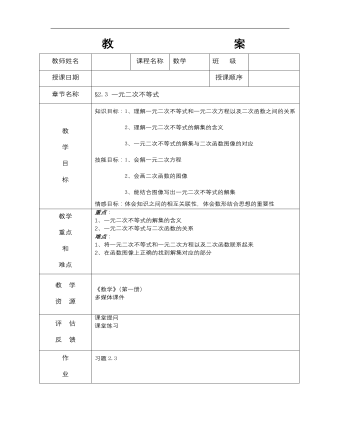
【高教版】中职数学基础模块上册:2.3《一元二次不等式》教案设计
教师姓名 课程名称数学班 级 授课日期 授课顺序 章节名称§2.3 一元二次不等式教 学 目 标知识目标:1、理解一元二次不等式和一元二次方程以及二次函数之间的关系 2、理解一元二次不等式的解集的含义 3、一元二次不等式的解集与二次函数图像的对应 技能目标:1、会解一元二次方程 2、会画二次函数的图像 3、能结合图像写出一元二次不等式的解集 情感目标:体会知识之间的相互关联性,体会数形结合思想的重要性教学 重点 和 难点重点: 1、一元二次不等式的解集的含义 2、一元二次不等式与二次函数的关系 难点: 1、将一元二次不等式和一元二次方程以及二次函数联系起来 2、在函数图像上正确的找到解集对应的部分教 学 资 源《数学》(第一册) 多媒体课件评 估 反 馈课堂提问 课堂练习作 业习题2.3课后记本节课内容是比较重要的,是一元二次方程、一元二次函数、一元二次不等式的结合,相关知识点融会贯通,数形结合的思想方法在这有很好的运用。三种情况只要讲清楚一种,另外两种可由学生自行推出结论。
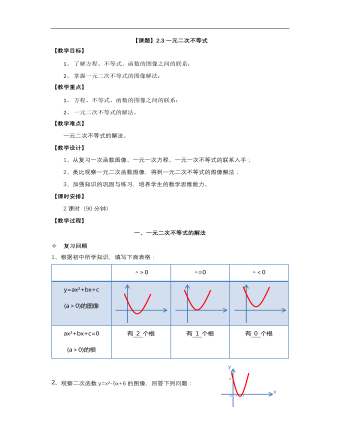
【高教版】中职数学基础模块上册:2.3《一元二次不等式》优秀教案
【教学目标】1、了解方程、不等式、函数的图像之间的联系;2、掌握一元二次不等式的图像解法;【教学重点】1、 方程、不等式、函数的图像之间的联系;2、 一元二次不等式的解法。【教学难点】 一元二次不等式的解法。【教学设计】 1、从复习一次函数图像、一元一次方程、一元一次不等式的联系入手;2、类比观察一元二次函数图像,得到一元二次不等式的图像解法;3、加强知识的巩固与练习,培养学生的数学思维能力。【课时安排】 2课时(90分钟)【教学过程】一、一元二次不等式的解法² 复习回顾1、根据初中所学知识,填写下面表格: △>0 △=0△<0y=ax²+bx+c (a>0)的图像ax²+bx+c=0 (a>0)的根有 2 个根有 1 个根有 0 个根2、观察二次函数y=x²-5x+6的图像,回答下列问题:(1)当y=0时,x取什么值?(2)二次函数y=x²-5x+6的图像与x轴交点的坐标是什么?(3)当y<0时,x的取值范围是什么?总结:由此看到,通过对函数y=x²-5x+6的图像的研究,可以求出不等式x²-5x+6>0与x²-5x+6<0的解集
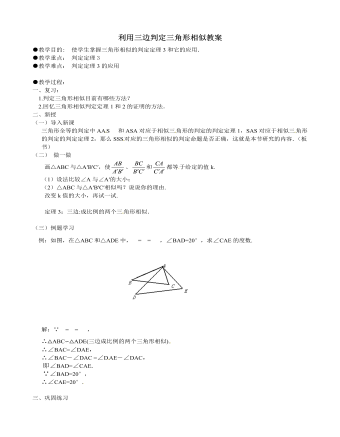
北师大初中数学九年级上册利用三边判定三角形相似2教案
(一)导入新课三角形全等的判定中AA S 和ASA对应于相似三 角形的判定的判定定理1,SAS对应于相似三 角形的判定的判定定理2,那么SSS 对应的三角形相似的判定命题是否正确,这就是本节研究的内容.(板书)(二) 做一做画△ABC与△A′B′C′,使 、 和 都等 于给定的值k.(1)设法比较∠A与∠A′的大小;(2)△ABC与△A′B′C′相似吗?说说你的理由.改变k值的大小,再试一试.定理3:三边:成比例的两个三 角形相似.(三)例题学习例:如图,在△ABC和△ADE中,ABAD=BCDE=ACAE ,∠BAD=20°,求∠CAE的度数.解:∵ABAD=BCDE=ACAE ,∴△ABC∽△ADE(三边成比例的两个三角形相似). ∴∠BAC=∠DAE,∴∠BAC-∠DAC =∠D AE-∠DAC,即∠BAD=∠CAE.∵∠BAD=20°,∴∠CAE=20°. 三、巩固练习四、小结本节学 习了相似三角形的判定定理3,使用时一定要注意它使用的条件.
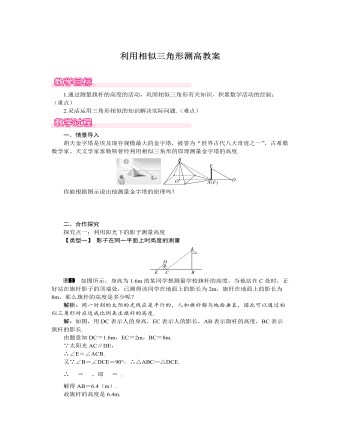
北师大初中数学九年级上册利用相似三角形测高2教案
[想一想]同学们经历了上述三种方法,你还能想出哪些测量旗杆高度的方法?你认为最优化的方法是哪种?思路点拔:1、如果旗杆周围有足够地空地使旗杆在太阳光照射下影子都在平地上,并能测出影子的长度,那么,可以在平地垂直树一根小棒,等到小棒的影子恰好等于棒高时,再量旗杆的影子,此时旗杆的影子长度就是这个旗杆的高度.2、可以采用立一个已知长度的参照物在旗杆旁照相后量出照片中旗杆与参照物的长度根据线段成比例来进行计算.3、拿一根知道长度的直棒,手臂伸直,不断调整自己的位置,使直棒刚好完全挡住旗杆,量出此时人到旗杆的距离、人手臂的长度和棒长,就可以利用三角形相似来进行计算.等等.第四环节 课堂小结1、本节课你学到了哪些知识?2、在运用科学知识进行实践过程中,你是否想到最优的方法?3、在与同伴合作交流中,你对自己的表现满意吗?第五环节 布置作业,反思提炼
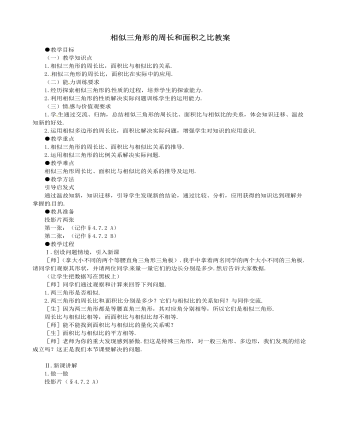
北师大初中数学九年级上册相似三角形的周长和面积之比2教案
●教学目标(一)教学知识点1.相似三角形的周长比,面积比与相似比的关系.2. 相似三角形的周长比,面积比在实际中的应用.(二)能 力训练要求1.经历探索相似三角形的 性质的过程,培养学生的探索能力.2.利用相似三角形的性质解决实际问题训练学生的运用能力.(三)情 感与价值观要求1.学 生通过交流、归纳,总结相似三角形的周长比、面积比与相似比的关系,体会知识迁移、温故知新的好处.2.运用相似多边形的周长比,面积比解决实际问题,增强学生对知识的应用意识.●教学重点1.相似三角形的周长比、面积比与相似比关系的推导.2.运用相似三角形的比例关系解决实际问题.●教学难点相似三角形周长比、面积比与相似比的关系的推导及运用.●教学方法引导启发式通过温故知新,知识迁移,引导学生发现新的结论,通过比较、分析,应用获得的知识达到理解并掌握的 目的.●教具准备投影片两张第一张:(记作§4.7.2 A)第二张:(记作§4.7.2 B)
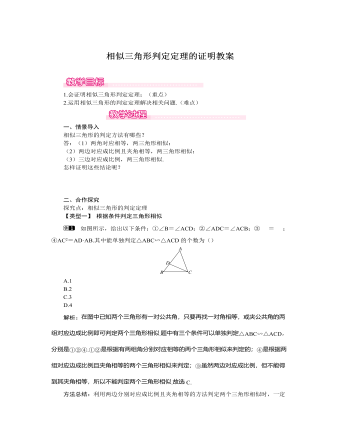
北师大初中数学九年级上册相似三角形判定定理的证明1教案
当Δ=l2-4mn<0时,存在以P、A、B三点为顶点的三角形与以P、C、D三点为顶点的三角形相似的一个点P;当Δ=l2-4mn=0时,存在以P、A、B三点为顶点的三角形与以P、C、D三点为顶点的三角形相似的两个点P;当Δ=l2-4mn>0时,存在以P、A、B三点为顶点的三角形与以P、C、D三点为顶点的三角形相似的三个点P.方法总结:由于相似情况不明确,因此要分两种情况讨论,注意要找准对应边.三、板书设计相似三角形判定定理的证明判定定理1判定定理2判定定理3本课主要是证明相似三角形判定定理,以学生的自主探究为主,鼓励学生独立思考,多角度分析解决问题,总结常见的辅助线添加方法,使学生的推理能力和几何思维都获得提高,培养学生的探索精神和合作意识.
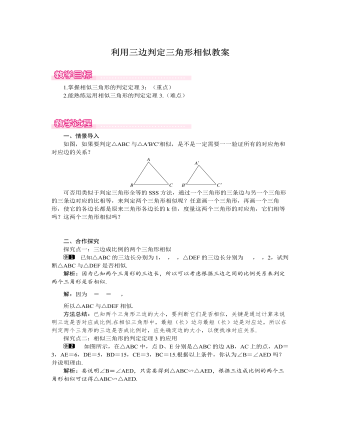
北师大初中数学九年级上册利用三边判定三角形相似1教案
同理,图③中,三角形的三边长分别为2,5,3;同理,图④中,三角形的三边长分别为2,5,13.∵21=22=105=2,∴图②中的三角形与△ABC相似.方法总结:(1)各个图形中的三角形均为格点三角形,可以根据勾股定理求出各边的长,然后根据三角形三边的长度是否成比例来判断两个三角形是否相似;(2)判断三边是否成比例,可以将三角形的三边长按大小顺序排列,然后分别计算他们对应边的比,最后由比值是否相等来确定两个三角形是否相似.三、板书设计相似三角形的判定定理3:三边成比例的两个三角形相似.从学生已学的知识入手,通过设置问题,引导学生进行计算、推理和归纳,提高分析问题和解决问题的能力.感受两个三角形相似的判定定理3与全等三角形判定定理(SSS)的区别与联系,体会事物间一般到特殊、特殊到一般的关系.让学生经历从实验探究到归纳证明的过程,发展学生的合情推理能力,培养学生与他人交流、合作的意识和品质.
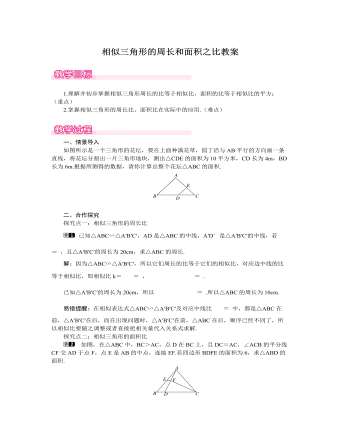
北师大初中数学九年级上册相似三角形的周长和面积之比1教案
解:∵CF平分∠ACB,DC=AC,∴CF是△ACD的中线,即F是AD的中点.∵点E是AB的中点,∴EF∥BD,且EFBD=12.∴∠B=∠AEF,∠ADB=∠AFE,∴△AEF∽△ABD.∴S△AEFS△ABD=(12)2=14.∵S△AEF=S△ABD-S四边形BDFE=S△ABD-6,∴S△ABD-6S△ABD=14.∴S△ABD=8,即△ABD的面积为8.易错提醒:在运用“相似三角形的面积比等于相似比的平方”这一性质时,同样要注意是对应三角形的面积比,在本题中不要犯由EF:BD=1:2得S△AEF:S△ABD=1:2,或S△AEF:S四边形BDFE=1:2之类的错误.三、板书设计相似三角形的周长和面积之比:相似三角形的周长比等于相似比,面积比等于相似比的平方.经历相似三角形的性质的探索过程,培养学生的探索能力.通过交流、归纳,总结相似三角形的周长比、面积比与相似比的关系,体验化归思想.运用相似多边形的周长比,面积比解决实际问题,训练学生的运用能力,增强学生对知识的应用意识.
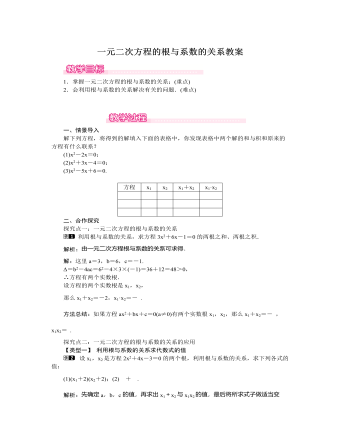
北师大初中数学九年级上册一元二次方程的根与系数的关系1教案
方程有两个不相等的实数根.综上所述,m=3.易错提醒:本题由根与系数的关系求出字母m的值,但一定要代入判别式验算,字母m的取值必须使判别式大于0,这一点很容易被忽略.三、板书设计一元二次方程的根与系数的关系关系:如果方程ax2+bx+c=0(a≠0) 有两个实数根x1,x2,那么x1+x2 =-ba,x1x2=ca应用利用根与系数的关系求代数式的值已知方程一根,利用根与系数的关系求方程的另一根判别式及根与系数的关系的综合应用让学生经历探索,尝试发现韦达定理,感受不完全的归纳验证以及演绎证明.通过观察、实践、讨论等活动,经历发现问题、发现关系的过程,养成独立思考的习惯,培养学生观察、分析和综合判断的能力,激发学生发现规律的积极性,激励学生勇于探索的精神.通过交流互动,逐步养成合作的意识及严谨的治学精神.
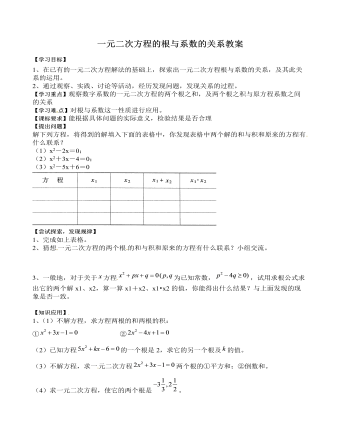
北师大初中数学九年级上册一元二次方程的根与系数的关系2教案
3、一般地,对于关于 方程 为已知常数, ,试用求根公式求出它的两个解x1、x2,算一算x1+x2、x1?x2的值,你能得出什么结果?与上面发现的现象是否一致。【知识应用】 1、(1)不解方程,求方程两根的和两根的积:① ② (2)已知方程 的一个根是2,求它的另一个根及 的值。(3)不解方程,求一 元二次方程 两个根的①平方和;②倒数和。(4)求一元二次方程,使它的两个根是 。【归纳小结】【作业】1、已知方程 的一个根是1,求它的另一个根及 的值。2、设 是方程 的两个根,不解方程,求下列各式的值。① ;② 3、求一个一元次方程,使它的两 个根分别为:① ;② 4、下列方程两根的和与两根的积各是多少 ?① ; ② ; ③ ; ④ ;
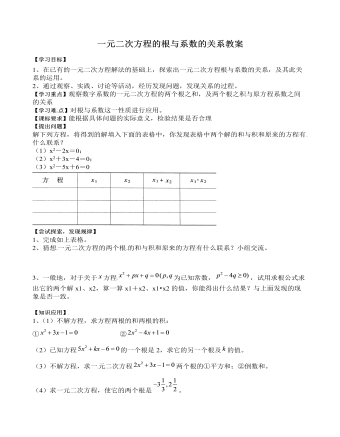
北师大初中数学九年级上册一元二次方程的根与系数的关系2教案
2、猜想 一元二次方程的两个根 的和与积和原来的方程有什么联系?小组交流。3、一般地,对于关于 方程 为已知常数, ,试用求根公式求出它的两个解x1、x2,算一算x1+x2、x1?x2的值,你能得出什么结果?与上面发现的现象是否一致。【知识应用】 1、(1)不解方程,求方程两根的和两根的积:① ② (2)已知方程 的一个根是2,求它的另一个根及 的值。(3)不解方程,求一 元二次方程 两个根的①平方和;②倒数和。(4)求一元二次方程,使它的两个根是 。【归纳小结】【作业】1、已知方程 的一个根是1,求它的另一个根及 的值。2、设 是方程 的两个根,不解方程,求下列各式的值。① ;② 3、求一个一元次方程,使它的两 个根分别为:① ;② 4、下列方程两根的和与两根的积各是多少 ?① ; ② ; ③ ; ④ ;
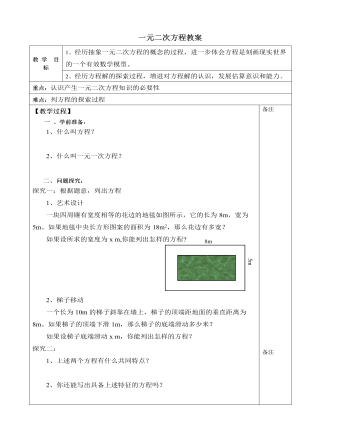
北师大初中数学九年级上册一元二次方程2教案
三、课堂检测:(一)、判断题(是一无二次方程的在括号内划“√”,不是一元二次方程的,在括号内划“×”)1. 5x2+1=0 ( ) 2. 3x2+ +1=0 ( )3. 4x2=ax(其中a为常数) ( ) 4.2x2+3x=0 ( )5. =2x ( ) 6. =2x ( ) (二)、填空题.1.方程5(x2- x+1)=-3 x+2的一般形式是__________,其二次项是__________,一次项是__________,常数项是__________.2.如果方程ax2+5=(x+2)(x-1)是关于x的一元二次方程,则a__________.3.关于x的方程(m-4)x2+(m+4)x+2m+3=0,当m__________时,是一元二次方程,当m__________时,是一元一次方程。四、学习体会:五、课后作业
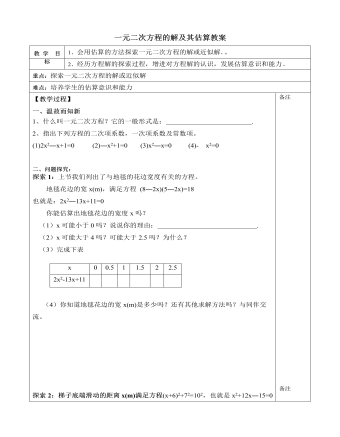
北师大初中数学九年级上册一元二次方程的解及其估算2教案
探索1:上节我们列出了与地毯的花边宽度有关的方程。地毯花边的宽x(m),满足方程 (8―2x)(5―2x)=18也就是:2x2―13x+11=0你能估算出地毯花边的宽度x吗?(1)x可能小于0吗?说说你的理由;_____________________________.(2)x可能大于4吗?可能大于2.5吗?为什么?(3)完成下表x 0 0.5 1 1.5 2 2.52x2-13x+11 (4)你知道地毯花边的宽x(m)是多少吗?还有其他求解方法吗?与同伴交流。探索2:梯子底端滑动的距离x(m)满足方程(x+6)2+72=102,也就是x2+12x―15=0(1)你能猜出滑动距离x(m)的大致范围吗?(2)x的整数部分是_____?十分位是_______?x 0 x2+12x-15 所以 ___<x<___进一步计算x x2+12x-15 所以 ___<x<___因此x 的整数部分是___,十分位是___.三、当堂训练:完成课本34页随堂练习四、学习体会:五、课后作业
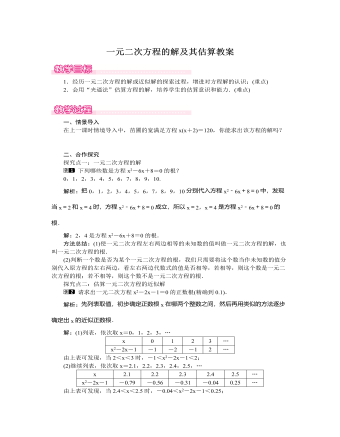
北师大初中数学九年级上册一元二次方程的解及其估算1教案
方法总结:(1)利用列表法估算一元二次方程根的取值范围的步骤是:首先列表,利用未知数的取值,根据一元二次方程的一般形式ax2+bx+c=0(a,b,c为常数,a≠0)分别计算ax2+bx+c的值,在表中找到使ax2+bx+c可能等于0的未知数的大致取值范围,然后再进一步在这个范围内取值,逐步缩小范围,直到所要求的精确度为止.(2)在估计一元二次方程根的取值范围时,当ax2+bx+c(a≠0)的值由正变负或由负变正时,x的取值范围很重要,因为只有在这个范围内,才能存在使ax2+bx+c=0成立的x的值,即方程的根.三、板书设计一元二次方程的解的估算,采用“夹逼法”:(1)先根据实际问题确定其解的大致范围;(2)再通过列表,具体计算,进行两边“夹逼”,逐步获得其近似解.“估算”在求解实际生活中一些较为复杂的方程时应用广泛.在本节课中让学生体会用“夹逼”的思想解决一元二次方程的解或近似解的方法.教学设计上,强调自主学习,注重合作交流,在探究过程中获得数学活动的经验,提高探究、发现和创新的能力.
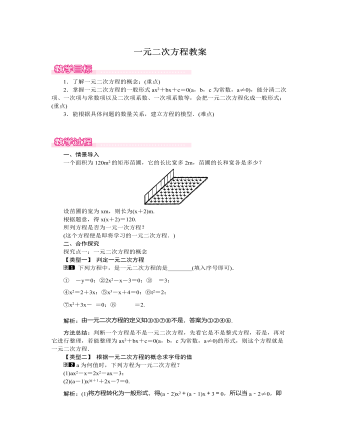
北师大初中数学九年级上册一元二次方程1教案
解:设需要剪去的小正方形边长为xcm,则纸盒底面的长方形的长为(19-2x)cm,宽为(15-2x)cm.根据题意,得(19-2x)(15-2x)=81.整理,得x2-17x+51=0(x<152).方法总结:列方程最重要的是审题,只有理解题意,才能恰当地设出未知数,准确地找出已知量和未知量之间的等量关系,正确地列出方程.在列出方程后,还应根据实际需求,注明自变量的取值范围.三、板书设计一元二次方程概念:只含有一个未知数x的整式方 程,并且都可以化成ax2+bx+c =0(a,b,c为常数,a≠0)的形式一般形式:ax2+bx+c=0(a,b,c为常 数,a≠0),其中ax2,bx,c 分别称为二次项、一次项和 常数项,a,b分别称为二次 项系数和一次项系数本课通过丰富的实例,让学生观察、归纳出一元二次方程的有关概念,并从中体会方程的模型思想.通过本节课的学习,应该让学生进一步体会一元二次方程也是刻画现实世界的一个有效数学模型,初步培养学生的数学来源于实践又反过来作用于实践的辩证唯物主义观点,激发学生学习数学的兴趣.
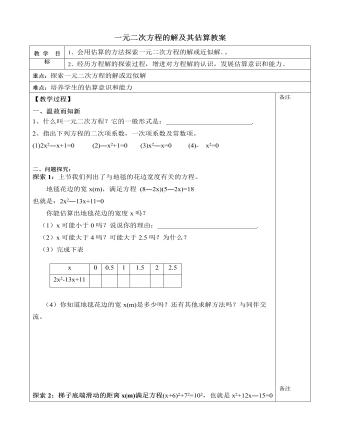
北师大初中数学九年级上册一元二次方程的解及其估算2教案
(1)x可能小于0吗?说说你的理由;_____________________________.(2)x可能大于4吗?可能大于2.5吗?为什么?(3)完成下表x 0 0.5 1 1.5 2 2.52x2-13x+11 (4)你知道地毯花边的宽x(m)是多少吗?还有其他求解方法吗?与同伴交流。探索2:梯子底端滑动的距离x(m)满足方程(x+6)2+72=102,也就是x2+12x―15=0(1)你能猜出滑动距离x(m)的大致范围吗?(2)x的整数部分是_____?十分位是_______?x 0 x2+12x-15 所以 ___<x<___进一步计算x x2+12x-15 所以 ___<x<___因此x 的整数部分是___,十分位是___.三、当堂训练:完成课本34页随堂练习四、学习体会:五、课后作业
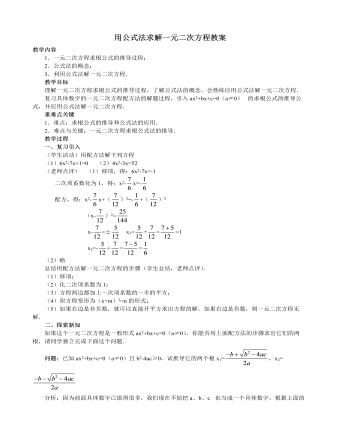
北师大初中数学九年级上册用公式法求解一元二次方程2教案
二、填空题1.一元二次方程ax2+bx+c=0(a≠0)的求根公式是________,条件是________.2.当x=______时,代数式x2-8x+12的值是-4.3.若关于x的一元二次方程(m-1)x2+x+m2+2m-3=0有一根为0,则m的值是_____.三、综合提高题1.用公式法解关于x的方程:x2-2ax-b2+a2=0.2.设x1,x2是一元二次方程ax2+bx+c=0(a≠0)的两根,(1)试推导x1+x2=- ,x1·x2= ;(2)求代数式a(x13+x23)+b(x12+x22)+c(x1+x2)的值.3.某电厂规定:该厂家属区的每户居民一个月用电量不超过A千瓦时,那么这户居民这个月只交10元电费,如果超过A千瓦时,那么这个月除了交10元用电费外超过部分还要按每千瓦时 元收费.(1)若某户2月份用电90千瓦时,超过规定A千瓦时,则超过部分电费为多少元?(用A表示)(2)下表是这户居民3月、4月的用电情况和交费情况
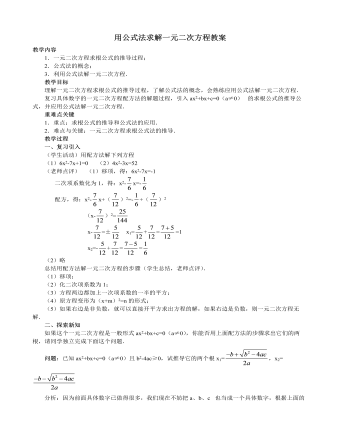
北师大初中数学九年级上册用公式法求解一元二次方程2教案
二、填空题1.一元二次方程ax2+bx+c=0(a≠0)的求根公式是________,条件是________.2.当x=______时,代数式x2-8x+12的值是-4.3.若关于x的一元二次方程(m-1)x2+x+m2+2m-3=0有一根为0,则m的值是_____.三、综合提高题1.用公式法解关于x的方程:x2-2ax-b2+a2=0.2.设x1,x2是一元二次方程ax2+bx+c=0(a≠0)的两根,(1)试推导x1+x2=- ,x1·x2= ;(2)求代数式a(x13+x23)+b(x12+x22)+c(x1+x2)的值.3.某电厂规定:该厂家属区的每户居民一个月用电量不超过A千瓦时,那么这户居民这个月只交10元电费,如果超过A千瓦时,那么这个月除了交10元用电费外超过部分还要按每千瓦时 元收费.(1)若某户2月份用电90千瓦时,超过规定A千瓦时,则超过部分电费为多少元?(用A表示)(2)下表是这户居民3月、4月的用电情况和交费情况
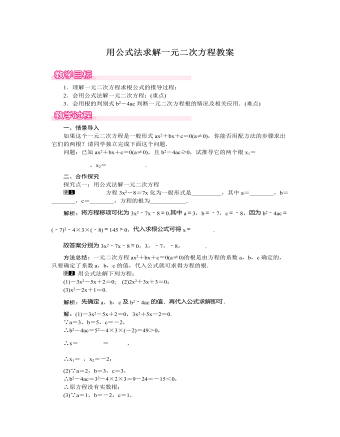
北师大初中数学九年级上册用公式法求解一元二次方程1教案
易错提醒:利用b2-4ac判断一元二次方程根的情况时,容易忽略二次项系数不能等于0这一条件,本题中容易误选A.【类型三】 根的判别式与三角形的综合应用已知a,b,c分别是△ABC的三边长,当m>0时,关于x的一元二次方程c(x2+m)+b(x2-m)-2m ax=0有两个相等的实数根,请判断△ABC的形状.解析:先将方程转化为一般形式,再根据根的判别式确定a,b,c之间的关系,即可判定△ABC的形状.解:将原方程转化为一般形式,得(b+c)x2-2m ax+(c-b)m=0.∵原方程有两个相等的实数根,∴(-2m a)2-4(b+c)(c-b)m=0,即4m(a2+b2-c2)=0.又∵m≠0,∴a2+b2-c2=0,即a2+b2=c2.根据勾股定理的逆定理可知△ABC为直角三角形.方法总结:根据一元二次方程根的情况,利用判别式得到关于一元二次方程系数的等式或不等式,再结合其他条件解题.

北师大初中数学九年级上册用公式法求解一元二次方程1教案
∴(-2m a)2-4(b+c)(c-b)m=0,即4m(a2+b2-c2)=0.又∵m≠0,∴a2+b2-c2=0,即a2+b2=c2.根据勾股定理的逆定理可知△ABC为直角三角形.方法总结:根据一元二次方程根的情况,利用判别式得到关于一元二次方程系数的等式或不等式,再结合其他条件解题.三、板书设计用公式法解一元二次方程求根公式:x=-b±b2-4ac2a(a≠0,b2-4ac≥0)用公式法解一元二次 方程的一般步骤①化为一般形式②确定a,b,c的值③求出b2-4ac④利用求根公式求解一元二次方程根的判别式经历从用配方法解数字系数的一元二次方程到解字母系数的一元二次方程,探索求根公式,发展学生合情合理的推理能力,并认识到配方法是理解求根公式的基础.通过对求根公式的推导,认识到一元二次方程的求根公式适用于所有的一元二次方程,操作简单.体会数式通性,感受数学的严谨性和数学结论的确定性.提高学生的运算能力,并养成良好的运算习惯.

